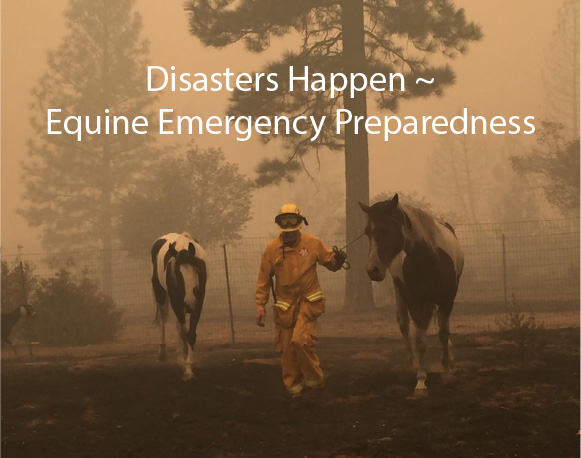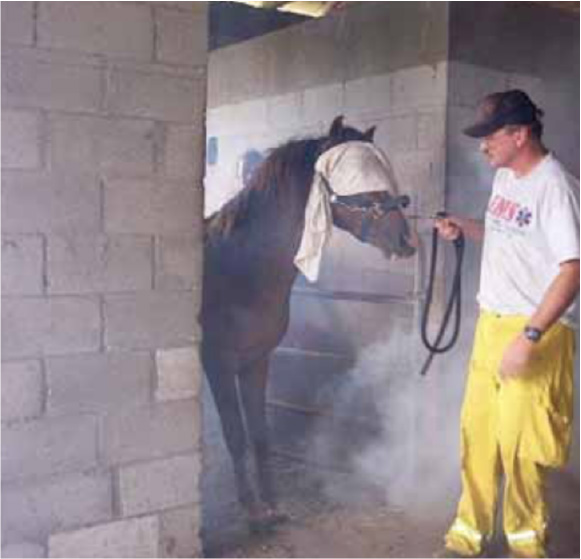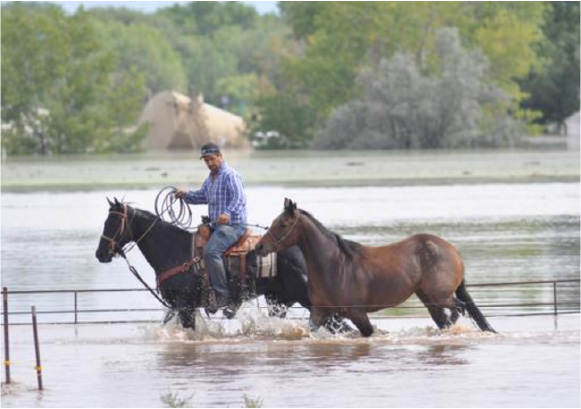Disasters Happen ~ Equine Emergency Preparedness
By CH Staff

Horses in your care are your responsibility. You will sleep better knowing you have done the utmost to keep those horses safe and sound. Here’s a ‘heads up’ of action you can take now, to help ensure the best possible outcome if disaster strikes.
Disasters are Different
By their very nature, Mother Nature in this case, the major disasters of fire, flood, earthquake, tornado and hurricanes do happen but all pose different questions. While their nature, identity and location may determine whether you evacuate your family both two-legged and four-legged, the steps you take to be prepared are similar for the equines in your charge no matter what type of disaster is prevalent in your geographic region.
Sobering Facts
The majority of horse deaths that occur as a result of tornados and hurricanes happen due to collapsed barns; electrocution; flying debris; kidney failure due to dehydration; are hit by traffic on roadways; wire entanglement.
The majority of horses that die in fires and floods happen due to smoke inhalation; burns; drowning (especially if locked in buildings or stalls with no escape option); dehydration; inability to escape due to flash floods; puncture wounds and injuries from floating debris or damage from toxic substances in the water.
Horses that could be rescued are frequently left behind by emergency services because no-one taught them how to load into a trailer and/or local responders do not know how to halter, handle or lead a horse. Always have extra lead ropes and halter available and teach people how to use them.
Weather the Disaster
Weather the disaster with smart planning strategies and keep the provisions fresh and the information up to date.
Put plans in writing and make everyone aware.
Best-laid plans won’t be much help if no-one knows about them. Laminate the information such as emergency numbers, exit routes, buddy farms etc. and post where it is clearly visible.
Run through the information with all barn users and neighbors/family and friends and invite your local responders/firefighters to come out to your farm and learn how to handle a horse, put on a halter, where the exit locations are and where emergency notes are posted.
Put all emergency numbers in your phone for quick access and assure other horse care members all do the same. Include your vet, his regular and emergency numbers and have a back up vet number just in case, your farrier, your insurance carrier/policy number.
Have your I.C.E. info and emergency numbers on a wallet sized laminated card that you can hand out to first responders on scene, neighbors and anyone involved in the care of your horses in your absence.
Have your own program for a specific emergency e.g. for floods do you have a site on higher ground to which you can evacuate if enough lead time is given? During hurricane season (June 1st through November 30th), have you determined the plan of action such as whether horses will be pastured or brought into a secure well-built barn?
Have a battery radio or other device that is not dependent on electricity to keep up to date with emergency updates.
Double Up on I.D.
Permanent ID: Microchipping (required in some States), tattoos or freeze branding.
Microchipping is fairly cheap to obtain for your horse. Certainly it is one of the best ways to protect the identity of any animal. It can also be beneficial to attach other forms of ID and information to your horse in an emergency, ones that can be easily read without the need of a chip reader.
Temporary I.D. options include: Luggage tags (waterproof ones) ; waterproof livestock markers/crayons; clip marking; mane attachments; fetlock bands; hurricane collars; leather halter with farm name (don’t use nylon halters as these may melt into equine facial tissue during extreme heat and won’t break if the halter becomes caught on a tree branch or other object); information can also be duct taped onto the horse or braided into the tail. There are many ‘portable file carriers’ on the market so explore the options and have the information handy and ready to place on the horse. These portable carriers retail for as little as $20 and can be added to the horse’s mane in an instant.
Ideally the portable file carrier would include all I.C.E. information or “in case of emergency” information including your horse’s vaccination records, known allergies, Coggins I.D. and ownership information i.e. your name, phone number, address and secondary phone number for someone outside of the area such as a family member that they could reach in the event your cell phone was down or lost.
While one I.D. may be enough, two I.D.’s are better. If one comes off the other may be the one that survives and reunites you with your horse.
Photos: Take photos of your horse from all four sides so that you have identification handy should you need it. Highlight areas of the horse that showcase identifying marks. Print these photos out and keep copies handy for posting in both digital and print format.
Also take photos of your barn and tack and equipment and store them offsite either digitally or with friends and family just in case of a catastrophic loss of property or theft of equipment following evacuation.
Horse Health Papers
While many States will waive the need for a Health Certificate to cross a State border during an emergency it is imperative your horse is up to date on his vaccinations and has a current Coggins.
This not only protects your horse from disease, if your horse is received at a shelter he won’t be subject to further vaccinations that may otherwise be required for entry.
Escape Routes
Have at least two escape routes mapped out and drive them in advance of evacuation so you know where you are going. Account in advance for routes that are prone to flooding or will likely have issues with fallen trees and avoid these.
Have specific barns/shelter locations destinations that you have verified and checked out beforehand if possible. These would be locations your local emergency services team should be able to direct you to their established emergency preparedness programs such as fairgrounds and racetracks or/and your own pre-arrange locations with horse owning friends and family that live a distance away where you can shelter your horse in an emergency.
A buddy system with other horse owners in your area is a great way to communicate up to date information outside of emergency service providers. Set this up in advance and have a chain of call.
Know the most direct route to an equine surgery center in case you need to transport your horse.

Have Transport Equipment Ready
Keep your truck and trailer well maintained and ready to move with a full tank of gas, stored emergency medical supplies and food and water provisions, and bedding (see notes on what provisions to have ready below).
Make sure there is easy access to your trailer and it is parked without obstructions preventing its movement and with available space for loading horses. Keys should be placed somewhere easily available if needed.
Ensure all the horses on your property are taught to load. An evacuation is not the time to try and teach the horse to walk right on your trailer. Ensure they are taught to load at night and not just during daylight.
Charge Phones: Place a vehicle use cell charger/backup charger units in your vehicle and keep phones charged and ready to use. Have maps/directions/horse medical information in your glove box. Don’t forget a radio or device that is not driven by electricity that you can keep in touch with news broadcasts from the emergency departments. Know the major weather information channels such as www.theweatherchannel.com and www.noaa.com/gov
Don’t have a trailer? Use a buddy system and find other horse owners in your area that would be prepared to help you haul your horses in an emergency. It is wise to have a circle of buddies in a variety of areas, so that if one is caught in their own emergency situation another can jump in to help.
Know your evacuation routes and have an idea of countdown times. These can be obtained from your State Equine Disaster Preparedness Program.
Where will you resource your emergency notifications? Be aware in hurricane winds in excess of 35-40 mph may prevent you being allowed to transport your horses so always evacuate earlier rather than later and don’t wait to be asked to leave.
Before You Leave Your Property
If you have to leave horses or animals behind, place highly visible signage on the doors of the building and indicate how many animals are inside to help rescue workers.
Also cut off the power to your property before you leave, to avoid injuries due to downed power lines.
Place large equipment such as tractors in an open field where trees cannot fall on them.
Barn Readiness
It is important to be realistic about your barn and home. Is your property hazard free?
For fire and hurricane safety take action now to remove vegetation that is in close proximity to buildings or fences.
Can your barn withstand tropical force winds (35mph), Cat 1 hurricane force winds ( 74-05 mph) or Cat 2 hurricane force winds (96-110mph)? If not you need to make plans to evacuate and have a timeline to do so. Create a 5-6 days out plan down to 24 hours out.
A board fenced paddock without electrical wires overhead, no electrical fencing and only a limited amount of well rooted trees may be a safer option during a storm than a barn that has a flimsy roof or no sides.
If you own a horse property there should be NO barbed wire on the property anywhere, but if there is now is the time to remove it. Any rubbish piles, old rusty equipment or other debris, should be removed from the property. In a flood, hurricane or tornado, these materials become a liability and increase the risk of injury to your horse.
Also be aware that fire ants and snakes will seek higher ground during flooding so check your property and remove or treat nests to eradicate their presence while possible and always check your feed supplies and barns for their presence during a weather event.
Garden furniture and other items that are not tied down should be stacked and securely stored away before a storm arrives.
Keep all barn aisle-ways free of clutter such as tack boxes or other equipment and supplies.
Know where the power shut-off is for your facilities in case it is necessary to voluntarily switch off the supply due to downed power lines.
Keep well-maintained fire extinguishers at every entrance to the barns/buildings and have flashlights and back up batteries handy.
If you run a large horse facility have a back-up generator to provide a power supply. Keep the unit properly maintained (test it monthly) and full of fuel, with safely stored back up fuel supplies that would be enough to last at least a week.
Think about other animals you may own aside from horses that may require shelter and may not be transportable such as goats, cows, alpacas etc. and have a plan in place for them too. Have crates handy for carrying dogs/cats and smaller animals.
Special Needs for the Senior Horse
Older horses are subject to loss of sight and hearing, increased risk of colic and have increased medicinal dependency. Pay special attention to their specific needs.
Provisions
All stored provisions need to be kept fresh, whether that is grain or water. Rotate your emergency supplies regularly, at a minimum once every three months.
Feed
As a horse has such a delicate digestive system it is wise to store at least a one week supply of his regular feed, whether that be hay/grain or both. The grain should be kept in an airtight, waterproof container. Add a spare feed bucket to your stored supplies so you have one available just in case.
The hay should be on pallets and be securely tarped to protect it from weather or smoke and air pollutants.
Note: In advance of hurricanes where a large drop in barometric pressure may contribute to colic in horses, ask your vet now, whether it is a good idea to add a bran mash 2/3 days prior to the storm’s arrival or limit grain intake.

Water
Dehydration is a prevalent cause of death in horses during a natural disaster. Purchase 50 gallon barrels and keep filled with fresh water and store in a cool, dark place. Clean barrels with a bleach before rising and filling. Alternatively you can use garbage cans and line with a plastic bag. Fill all water troughs on the property.
You should store a one week supply for each horse on your property. Each horse should have 12-20 gallons per day stored. Have a spare water bucket in your storage area in case it is needed.
In the event of an emergency where the water supply becomes unsafe for us to drink, it most certainly will also be unsafe for your horse to drink too. So store a name brand, quality bleach with your provisions. To purify water add two drops of chlorine bleach per quart of water and let stand for 30 minutes before using.
Bedding
It is wise to have bedding materials available and kept dry for use, bags of shavings are ideal. If possible have a spare muck bucket, muck fork and at least a week’s supply handy in case you cannot garner more supplies for a while during an emergency.
Emergency First Aid Kit
You should have a complete kit for both human and equine needs available in your vehicle in case of evacuation and also available at your barn.
It is also a good idea to have a smaller, trail riding size kit available in case you need to ride your horses out for evacuation.
Communicate Your Plan
Whether you decide to leave or to stay during an emergency it is important to communicate your plan to friends and family.
While this may sound obvious, many times during the rush of the evacuation this can be overlooked risking first responders unnecessarily and causing undue upset to family and friends.
Let folks know when you leave and where you are planning to go (give options with addresses and phone numbers).
Post a visible note on building if there is no livestock remaining behind. This will save first responders a lot of time and personal risk.
Aftermath
Ensure there are no downed power lines or other hazards on the property.
Carefully inspect all animals on the property for any sign of injury.
If horses or other animals are missing notify your local animal control or disaster response team immediately.
Take pictures of all property damage for insurance claim filing.
Walk all pastures and remove debris. Ensure no trees branches/debris that are toxic to horses are present such as Red Maple.
Know signs of toxicity and illness in your horse and monitor for several days after the event. Always seek professional assistance if in doubt of the health of your horse.
Emergency Contact Resource List:
www.fema.gov
www.redcross.org
www.avma.org
www.nasar.org
www.usef.org
NY state horse council
local power company
www.ASPCA.org
www.horsecouncil.org
www.Americanhumanesociety.org
local mounted patrol units
mounted rescue organizations
www.missingpet.net
Expected aftermath issues to consider
Lack of staff to help with horses
Traffic congestion and resulting difficulty getting horses home
No mail delivery
No stores open or minimal provisions
No power or gas/fuel available
No towers, telephone service
No feed or other supplies available


